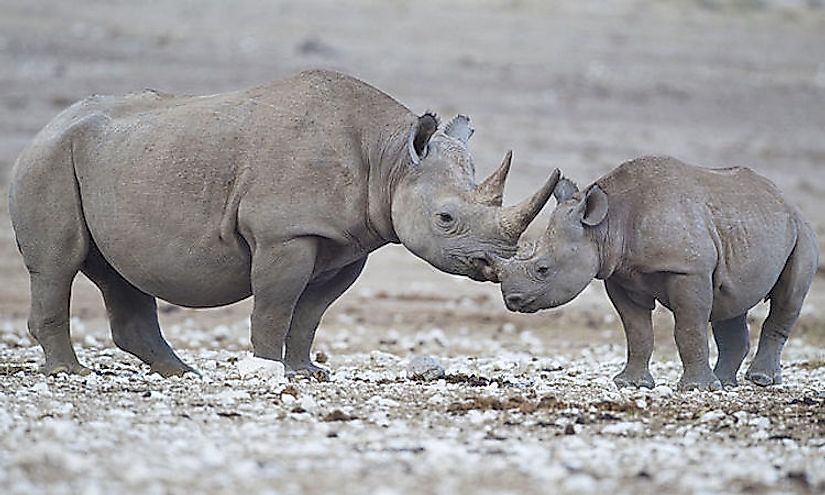Threatened Mammals Of Namibia

Namibia has a broad range of fauna which resides in its arid and semi-arid zones, along with the country’s coastline and in the sub-tropical region in the northeast. Namibia is one of the African countries which stand out regarding environmental conservation. Despite efforts to maintain sustainability, however, some mammals in the country are threatened due to factors such as poaching, human encroachment, and deforestation.
Chobe Black Rhinoceros
The Chobe black rhinoceros (Diceros bicornis chobiensis) is a subspecies of the black rhinoceros, native to some African countries. In Namibia, the animal is found in the Caprivi Strip. The height of a fully mature Chobe black rhinoceros ranges from 140cm to 180cm while the length ranges from 2.8 meters to 3.8 meters. Their larger size easily distinguishes the males from the females. The rhinoceros has two horns although sometimes a third horn may develop. These animals are aggressive especially at identified threats, and they also fight always with each other. They have an extensive habitat range and move from one place to another in search of vegetation and water. They feed during the morning and evening and remain inactive during the day when it is hot. A newborn calf begins to wean at two years and reaches sexual maturity at 5 to 7 years for females and 7 to 8 years for males. A Chobe black rhinoceros has a life expectancy of 35 to 50 years in the wild. Hunting and poaching remain the biggest threats to the Chobe black rhinoceros in Namibia. Efforts by the Namibian government in sustaining the animals’ numbers include Save the Rhino Trust founded in 1982. Through this foundation, reserves for the animals have been established and effectively managed to protect the rhinoceros.
African Bush Elephant
The African bush elephant (Loxodonta africana) is one of the vulnerable mammal species of Namibia. The animal resides in the savannah, which occupies nearly 64% of Namibia land mass. The animal is characterized by its large size, an average height of 3.3 meters in males and 2.6 meters for females. Large ears, long curving tusks and an upper lip composed of two extensions distinguish the animal from other elephants. The animal feeds on grass, shrubs, and trees and eats food adding up to over 50 tons because of their weak digestive system food is defecated without being entirely digested. The African bush elephant typically live in small groups headed by a matriarch. Poaching remains the major threat to the African bush elephant’s population in Namibia. National parks and reserves such as the Etosha National Park have been established in the country for its conservation.
African Wild Dog
The African wild dog (Lycaon pictus) is a threatened predator in Sub-Saharan Africa, including Namibia. The animal lives in open plains and has a vast habitat range. The animal is distinguished by a mottled coat of different colors, which is unique to each animal. They have four toes on each foot and big rounded ears. They live in packs and hunt antelopes and wildebeests. They also feed on birds and rodents in the absence of the larger animals. They live for 10 to 12 years and have a height of 30 inches on the shoulder.
The animals need a large expanse of land to survive and have been adversely affected by human encroachment. Increasing population pressure in Namibia remains the primary threat to the species alongside killings by humans and competition with other predators. The government and wildlife conservation organizations have established reserves to enable the animal to roam freely and undisturbed.
Transvaal Lion
The Transvaal lion (Panthera leo krugeri) is a subspecies of the lion which abounds in Southern Africa. Their habitat range is in the savannah, semi-arid zones and the grasslands. The male is distinguished from the female by a well-developed mane and a length of 2.6 to 3.2 meters while that of the female is 2.35 to 2.75 meters. Their height ranges from 0.92 to 1.23 meters at the shoulder. They mostly feed on herbivores and the hunting is by the females. Males become sexually mature after 2 to 3 years and females at two years after they are born. Their life cycle is 13 to 25 years. Human-lion conflicts, trophy hunting, and human encroachment are the major threats to the lion’s population in Namibia. The lion population is conserved majorly in the Kunene region and the Etosha National Park.
Other threatened mammals in Namibia are Southern blue whale, Southern fin whale, Southern sei whale, and Sperm whale, Hippopotamus, South African cheetah, South-western black rhinoceros, Black-footed cat, Hartmann’s mountain zebra and Southwest African lion. Ecotourism largely contributes to Namibia’s economy, necessitating effective conservation programs for the country’s wildlife. Communal conservancies, which are initiatives by communities, have reported a high level of success at wildlife conservation efforts.
Threatened Mammals Of Namibia
| Threatened Mammals of Namibia | Scientific Name |
|---|---|
| Chobe black rhinoceros | Diceros bicornis chobiensis |
| Southern blue whale | Balaenoptera musculus intermedia |
| Southern fin whale | Balaenoptera physalus quoyi |
| Southern sei whale | Balaenoptera borealis schlegelii |
| African wild dog | Lycaon pictus |
| African bush elephant | Loxodonta africana |
| Sperm whale Hippopotamus | Physeter catodon Hippopotamus amphibius |
| South African cheetah South-western black rhinoceros | Acinonyx jubatus jubatus Diceros bicornis occidentalis |
| Black-footed cat Hartmann's mountain zebra | Felis nigripes Equus zebra hartmannae |
| Transvaal lion Southwest African lion | Panthera leo krugeri Panthera leo bleyenberghi |







